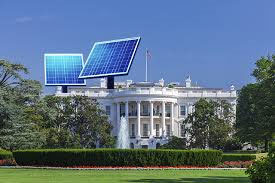Taking the opportunity to turn the US National Climate Assessment into action, President Obama announced new steps to stem climate change.
"Together the commitments we are announcing today prove there are cost effective ways to tackle climate change and create jobs at the same time. It will be good for the economy long term. Rising sea levels, drought, wildfires, more severe storms, those are bad for the economy, so we can’t afford to wait," he says.
The announcement comes as the finishing touches are put on the gleaming new White House solar system. Why so small? At 6.3 kilowatts (kW), it’s not much bigger than for a typical house. Officials say they can’t cover the entire roof with panels for "security" reasons, but in Germany, Chancellor Angela Merkel’s house has 128 kW.
We can’t find a photo, but this is pretty funny:

More than 300 business and public sector leaders confirmed pledges to significantly increase their use of solar, including Google, Yahoo, Ikea, and Goldman Sachs. Walmart repeated a previous announcement that it will double on-site solar by 2020 (sounds good, but still only brings them to 8% of demand). More impressive are new pledges from affordable housing and homebuilder developers, rural electric coops, school districts and city and state governments. Together, the pledges add up to 850 megawatts of solar.
Kaiser Permanente, for example, says it will increase on-site solar by as much as 50 megawatts, from 11.3 MW now, at hospitals and medical campuses. But that would still only provide 6-8% of its electricity used in California.
To build on momentum in energy efficiency and solar, President Obama announced Executive Orders in these areas:
- Build a skilled solar workforce;
- Provide innovative financing for deploying solar;
- Drive investment in energy upgrades to federal buildings;
- Improve appliance efficiency;
- Strengthen building codes.
Building a Skilled Solar Workforce: expand the Department of Energy’s (DOE) Solar Instructor Training Network at community colleges, with a goal of helping 50,000 people enter the solar industry by 2020. Since 2010, the network has trained 22,000 people at 400 community colleges in 49 states.
Innovative Financing for Solar: the General Services Administration is identifying opportunities for potential Federal Aggregated Solar Procurements in the Washington DC region and Northern California. Agencies would buy solar systems together, capitalizing on economies of scale.
Importantly, he said the Treasury Department and IRS will soon clarify rules to allow renewable energy financing through REITs.
Energy Efficiency:
$2 Billion More for Federal Building Upgrades: This doubles his 2011 commitment for upgrades over the next three years through the Better Buildings Challenge. Besides saving taxpayers billions on energy bills and promote energy independence, it will create tens of thousands of jobs in the hard-hit construction sector. There’s already a $2.7 billion pipeline in energy savings contracts.
26 new partners have signed on, adding another billion square feet of upgrades, including Wal-Mart, General Mills, City of San Diego, Jonathan Rose Companies, Hannon Armstrong, and Enterprise Community Partners.
Strengthen Building Codes: The latest version of the US building code – the 2013 edition of ANSI/ASHRAE/IES Standard 90.1 – will tighten energy efficiency by 8.5% from the previous version and up to 30% from most state energy codes.
High Performance Outdoor Lighting Accelerator: led by DOE, the goal is to replace over 500,000 outdoor lights and develop best practice approaches to municipal system-wide upgrades. Charter cities: Detroit; Kansas City, MO; West Palm Beach; Little Rock; and Huntington Beach, CA.
Appliances: DOE is issuing energy efficiency standards for electric motors and walk-in coolers and freezers today.
Read President Obama’s Fact Sheet which details these actions and pledges:
